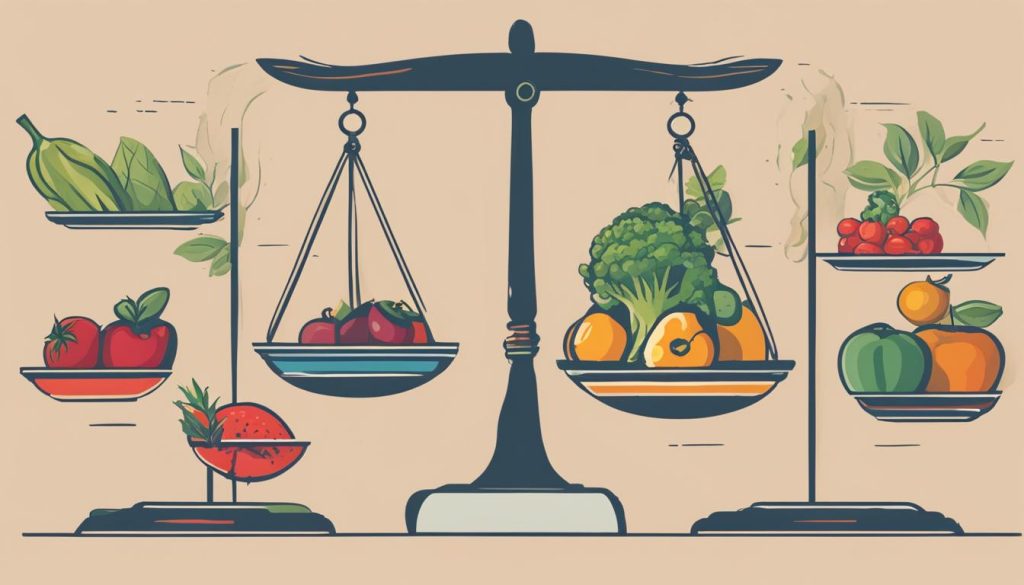In my continuous journey of holistic well-being, I’ve discovered that the key to health and wellness balance lies in the delicate art of juggling life’s many facets. Striving to attain this equilibrium, I’ve learned it isn’t just about crossing off to-do lists or meeting societal expectations; it’s about nurturing a harmonious relationship with myself through meaningful self-care practices. With each day, I become more adept at crafting a life where I can thrive, not just survive, celebrating both my small victories and grand triumphs in achieving balance in every aspect of my life.
Key Takeaways
- Embrace structured days to manage work and personal life effectively.
- Learn to prioritize tasks, acknowledging what is truly critical for your well-being.
- Implement firm boundaries to maintain health and wellness balance.
- Honor personal values and needs to achieve a holistic well-being.
- Regularly engage in self-care practices to rejuvenate and sustain balance.
Understanding the Importance of Health and Wellness Balance

The journey toward holistic health and wellness is a continuous process that profoundly influences both our mental and physical balance. It’s a multifaceted quest that shapes every facet of our lives, offering a buffer against the storms of stress and uncertainty. Let’s explore why maintaining this balance is critical and how it manifests in our day-to-day experiences.
Why Balance Matters: More Than Just Stress Management
Achieving a state of balance is about so much more than merely keeping stress at bay; it’s about nurturing a mind-body health synergy that can elevate quality of life. For me, balance is the keystone of productivity and personal fulfillment—a non-negotiable element in the equation of life. It’s about honing the ability to allocate energy where it’s most effective, thereby enhancing your capacity to thrive in all areas.
Identifying Symptoms of Imbalance in Daily Life
Recognizing the signs of imbalance is the first step toward restoring harmony. For instance, when I’m pulled too far in any one direction, I notice a decline in focus, a tension in my relationships, and a tendency to overlook my intrinsic needs. These symptoms signal a need for immediate attention to my wellness strategies.
How Achieving Balance Affects Mental and Physical Health
Through personal introspection and adherence to stress management techniques, I’ve witnessed a significant impact on both my mental clarity and physiological well-being. Harmony between aspects of life paves the way for robust health defenses, fostering resilience against both psychological and physical duress. And so, balance for me is not a luxury—it is essential.
| Aspect of Well-being | Imbalanced State | Balanced State |
|---|---|---|
| Mind | Constant worry, indecision | Clarity, focused thought |
| Body | Fatigue, frequent sickness | Vitality, strong immune response |
| Emotional State | Irritability, mood swings | Equanimity, emotional resilience |
| Productivity | Procrastination, inefficiency | Efficient task completion, goal attainment |
Embarking on a Journey to Holistic Health and Wellness

My quest towards attaining a well-rounded lifestyle led me to understand that holistic health and wellness are about much more than just diet and exercise. It’s a symphony of habits that infuse more energy and fulfillment into every facet of my daily existence. As I share my journey, I aspire to offer wellness tips and healthy lifestyle tips to guide others towards achieving balance in life.
The Multifaceted Approach: Incorporating Mind, Body, and Spirit
True wellness begins with a connection between mind, body, and spirit. This holistic approach has emboldened me to bridge the gap between my emotional needs by expressing myself freely and paying heed to my spiritual calling driven by personal values. I’ve seen how nurturing each aspect leads to profound self-growth and happiness.
- Emotional wellness through meaningful conversations and introspection.
- Spiritual fulfillment from meditation and reflection upon my life’s purpose.
- Intellectual satisfaction by continually learning and challenging my mind.
Finding Personal Boundaries and Nurturing Self-Care Practices
My journey emphasized the importance of establishing personal boundaries. This meant setting aside time strictly for self-care practices, whether it was an evening walk or a scheduled reading hour. By doing this, I was not only respecting my well-being but also setting a precedent for others about the value I place on my own health.
- Morning rituals to cultivate a peaceful start to the day.
- Regular breaks to ensure work-life balance and prevent burnout.
- Practices to deepen self-awareness, like journaling and mindfulness exercises.
Through my experiences, I’ve compiled a selection of self-care practices and wellness tips that contribute to a holistic lifestyle. It’s my hope that by sharing these insights, I can inspire others to find their unique path to holistic health and wellness.
Strategies to Achieve Mental and Physical Balance
Embarking on a path to maintaining wellness and balance requires an adaptable approach tailored to individual needs and lifestyles. In my experience, intentional planning and incorporating wellness strategies that resonate personally are invaluable. For sustainable integration, here are some effective practices I adhere to for a harmonious mental and physical balance:
- Setting rigid boundaries to delineate work hours, and allowing time for self-care practices like yoga.
- Consciously disconnecting from digital devices to reduce mental clutter and enhance focus.
- Allocating regular intervals for hobbies and leisure activities to nurture my creative expressions.
- Being assertive about my capabilities and willing to say “no” to maintain a healthy lifestyle.
- Adopting realistic schedules and breaking down tasks to avoid overcommitment at work and school.
- Communicating openly with family to share domestic responsibilities and foster a supportive environment.
Furthermore, here’s a breakdown to illustrate how I integrate these healthy lifestyle tips into various aspects of my daily routine:
| Time of Day | Physical Well-being | Mental & Emotional Well-being |
|---|---|---|
| Morning | Morning meditation & stretching routine | Review goals & express gratitude |
| Work Hours | Hourly short walks and hydration reminders | Scheduled deep work sessions for undisturbed focus |
| Evening | Participation in a local sports league | Quality time with family & digital detox |
| Weekends | Engage in an outdoor adventure | Cultivate a new skill or hobby |
Navigating through life’s everyday challenges while maintaining wellness and balance is a continuous endeavor. Adapting these methods to meet changing personal and professional demands ensures that my pursuit of balance is not just an objective, but a way of life. It’s a journey that fosters growth, resilience, and the joy that comes from living well.
Health and Wellness Balance: Crafting a Customized Plan for My Life
Every journey to health and wellness is a deeply personal endeavor, requiring us to look inward and determine what balance truly means on a singular level. In my own life, striking this equilibrium is more than a mere ambition; it’s a day-to-day commitment to harmonizing the various facets of my well-being. The foundation to my approach is a bespoke plan that places my values and needs at the forefront, evolving as I continue to grow and change through life’s unpredictable twists and turns.
Assessing Priorities and Setting Achievable Goals
In laying the groundwork for my wellness blueprint, I begin by assessing priorities crucial to obtaining a flourishing lifestyle. This means acknowledging the finite nature of time and energy, and thoughtfully determining where these precious resources are best invested. By pinpointing objectives which echo my core values, I can set realistic and achievable goals that guide me towards holistic health and wellness. As I aim for maintaining wellness and balance, the process of reaching these targets is just as rewarding as the outcomes they yield.
Implementing Mindfulness and Meditation for Inner Equilibrium
Mindfulness and meditation have opened new avenues for me to tap into a sense of inner equilibrium, drastically changing my relationship with stress and daily pressures. Adopting these self-care practices has empowered me to foster a quiet mind amid life’s cacophony, allowing me to approach each moment with clarity and presence. Scheduling treasured personal downtime, such as yoga sessions or serene walks, has become an essential aspect of achieving balance in life. Constantly reflecting and fine-tuning my wellness strategy ensures that I remain on track, keeping the wheel of well-being rolling smoothly ahead.
FAQ
What does health and wellness balance mean?
Health and wellness balance refers to the equilibrium between managing life’s necessities and desires without feeling overwhelmed or guilty. It encompasses a holistic approach to well-being that includes physical, mental, emotional, and spiritual health. This balance is achieved when we can engage in our work, relationships, and self-care practices in a way that sustains our overall health and satisfaction with life.
Why is balance in health and wellness important?
Balance is essential not just for stress management but also for our overall mental and physical health. When we have balance, we can better focus, have stronger relationships, and handle life’s challenges with confidence. It helps prevent burnout, keeps us grounded, and improves our problem-solving abilities. In essence, balance enhances productivity, improves our mental state, and fosters a profound sense of personal fulfillment.
What are the signs of imbalance in my daily life?
Signs of imbalance can include feeling constantly stressed or overwhelmed, difficulties concentrating, strained personal or professional relationships, and feelings of dissatisfaction or unhappiness with life. Physical symptoms may include fatigue, sleep disturbances, or illness. Being aware of these signs allows us to take proactive steps towards regaining our balance and improving our well-being.
How can achieving balance improve my mental and physical health?
Achieving balance can lead to improved mental health by reducing stress, boosting emotional well-being, and increasing resilience. Physically, it can lead to better sleep, a stronger immune system, and more energy. By maintaining balance, we support our mind and body’s ability to function optimally, making us healthier and happier overall.
What does a holistic approach to health and wellness include?
A holistic approach to health and wellness includes acknowledging and caring for the multiple aspects of our well-being. This includes nurturing not only our physical health with good nutrition and exercise but also our emotional well-being, intellectual stimulation, spiritual fulfillment, environmental connections, financial security, job satisfaction, and social interactions. It’s about understanding how these dimensions interconnect and affect our overall health.
How do I find my personal boundaries and implement self-care practices?
Finding personal boundaries involves understanding and accepting your limits, recognizing when to say ‘no,’ and not overcommitting yourself. Implementing self-care practices means prioritizing activities that nurture your mind, body, and soul, such as engaging in hobbies, relaxation techniques, exercise, or any activity that replenishes your energy and brings you joy. It’s about making time for yourself amid life’s demands.
What are some effective strategies for maintaining mental and physical balance?
Effective strategies for maintaining mental and physical balance include setting clear boundaries for work and personal time, being assertive, practicing saying “no,” personalized scheduling that considers realistic timelines, advocating for workload adjustments, and committing to regular self-care. These are complemented by seeing support when needed, engaging in relaxing activities, communicating openly about needs, and sharing responsibilities at home.
How do I craft a customized plan to achieve health and wellness balance in my life?
Crafting a customized plan involves assessing your current life situation, setting priorities, and creating achievable goals that resonate with your personal values. Incorporating mindfulness and meditation can help to maintain focus and inner calm. It’s also about scheduling non-negotiable downtime, such as relaxation or exercise, and regularly reviewing and adjusting your plan to ensure it remains aligned with your health and wellness goals.
What role do mindfulness and meditation play in achieving health and wellness balance?
Mindfulness and meditation are powerful tools for achieving health and wellness balance as they help to center the mind, reduce stress, and promote a state of calmness. These practices can improve concentration, enhance our emotional regulation, and support our ability to be present and fully engaged in the moment. By incorporating these techniques into our daily routine, we can foster a greater sense of inner equilibrium and clarity.

